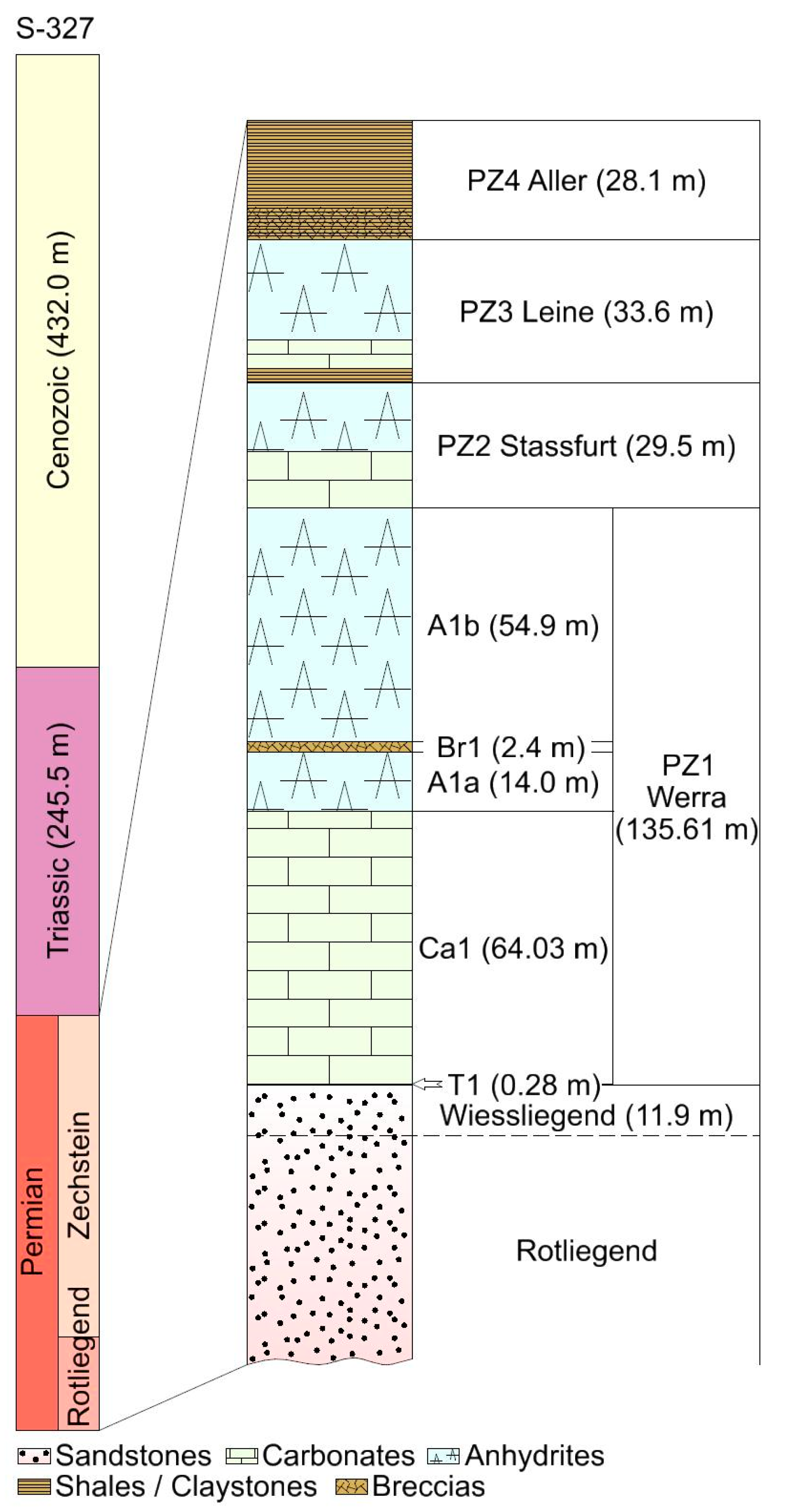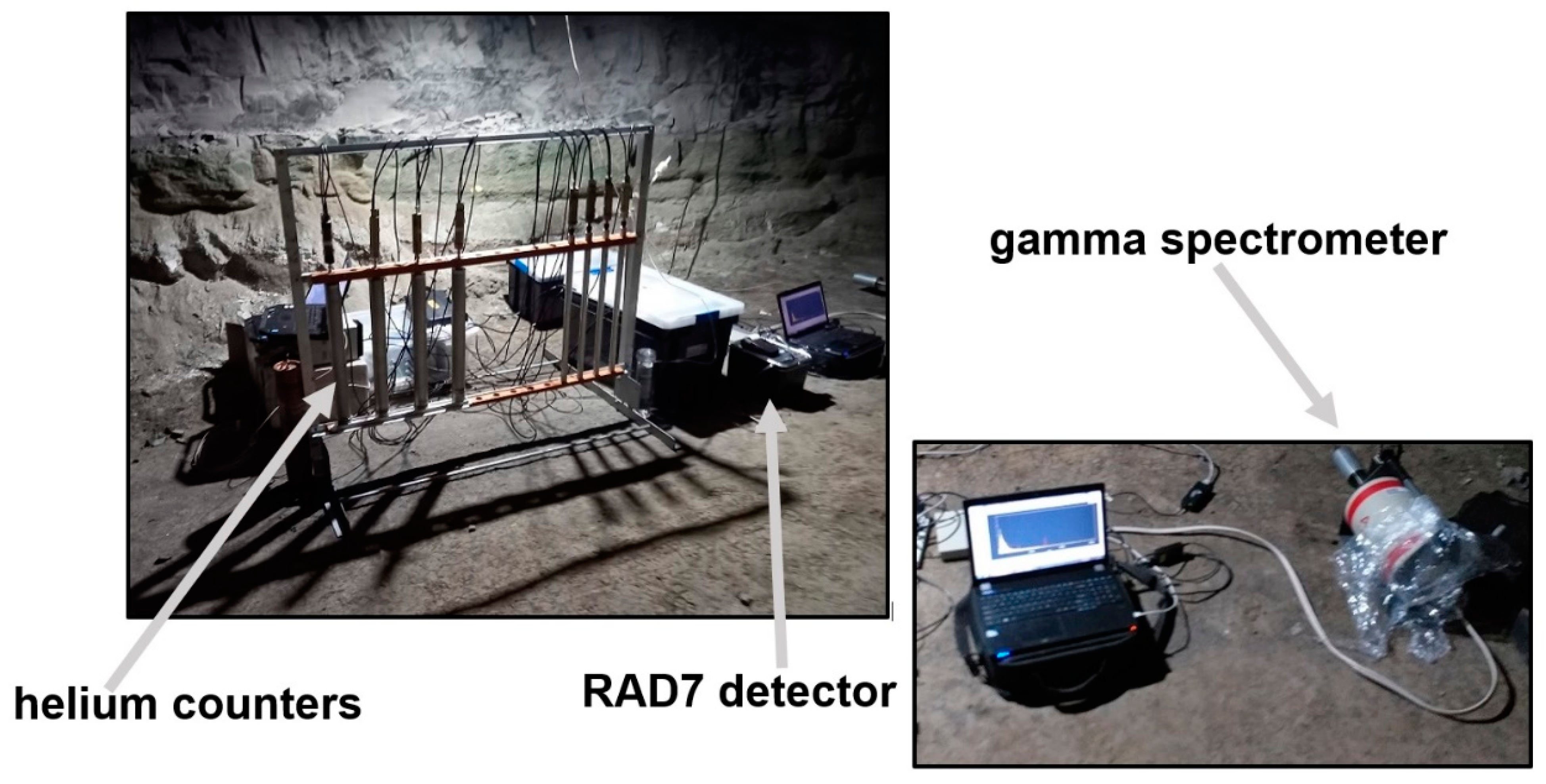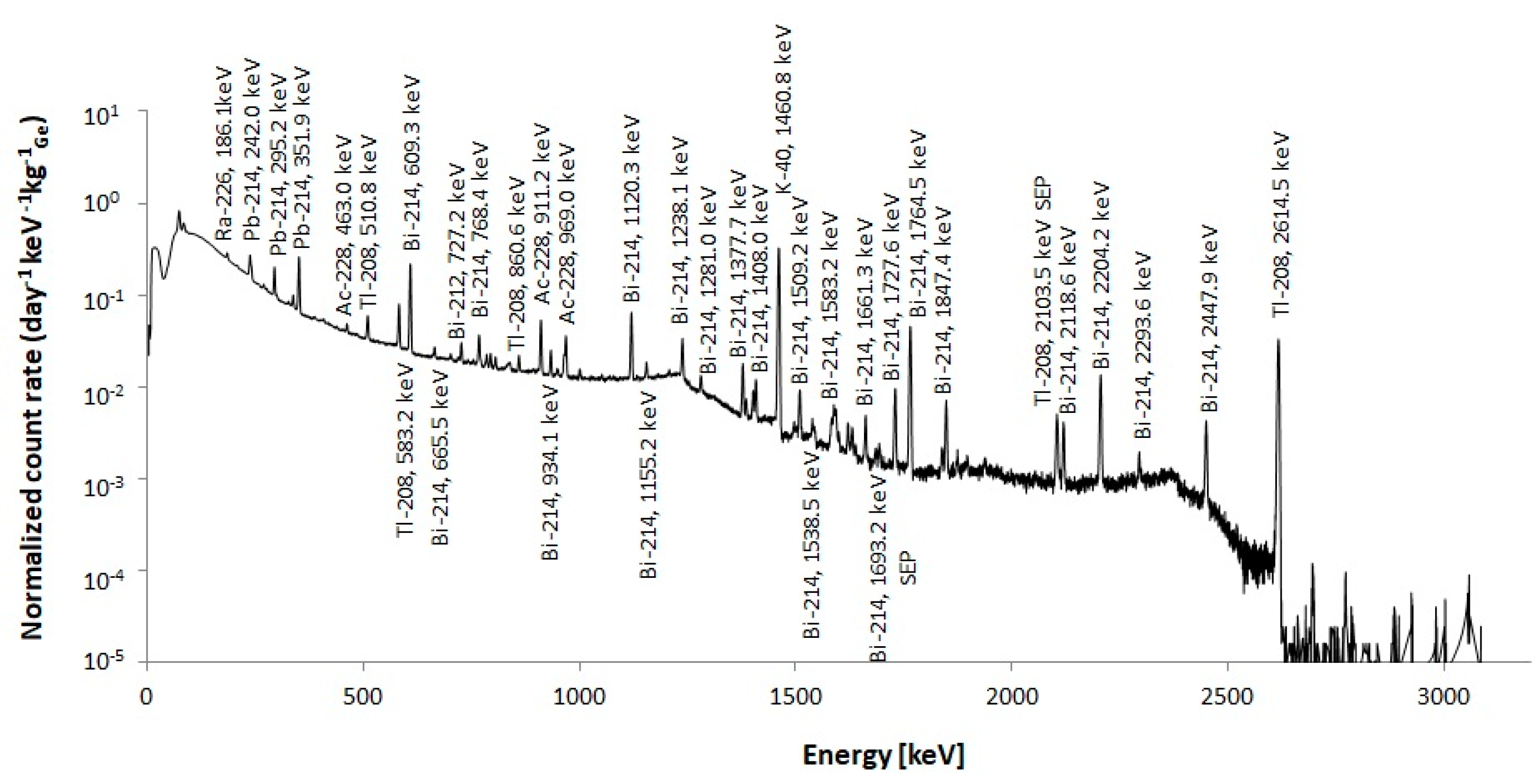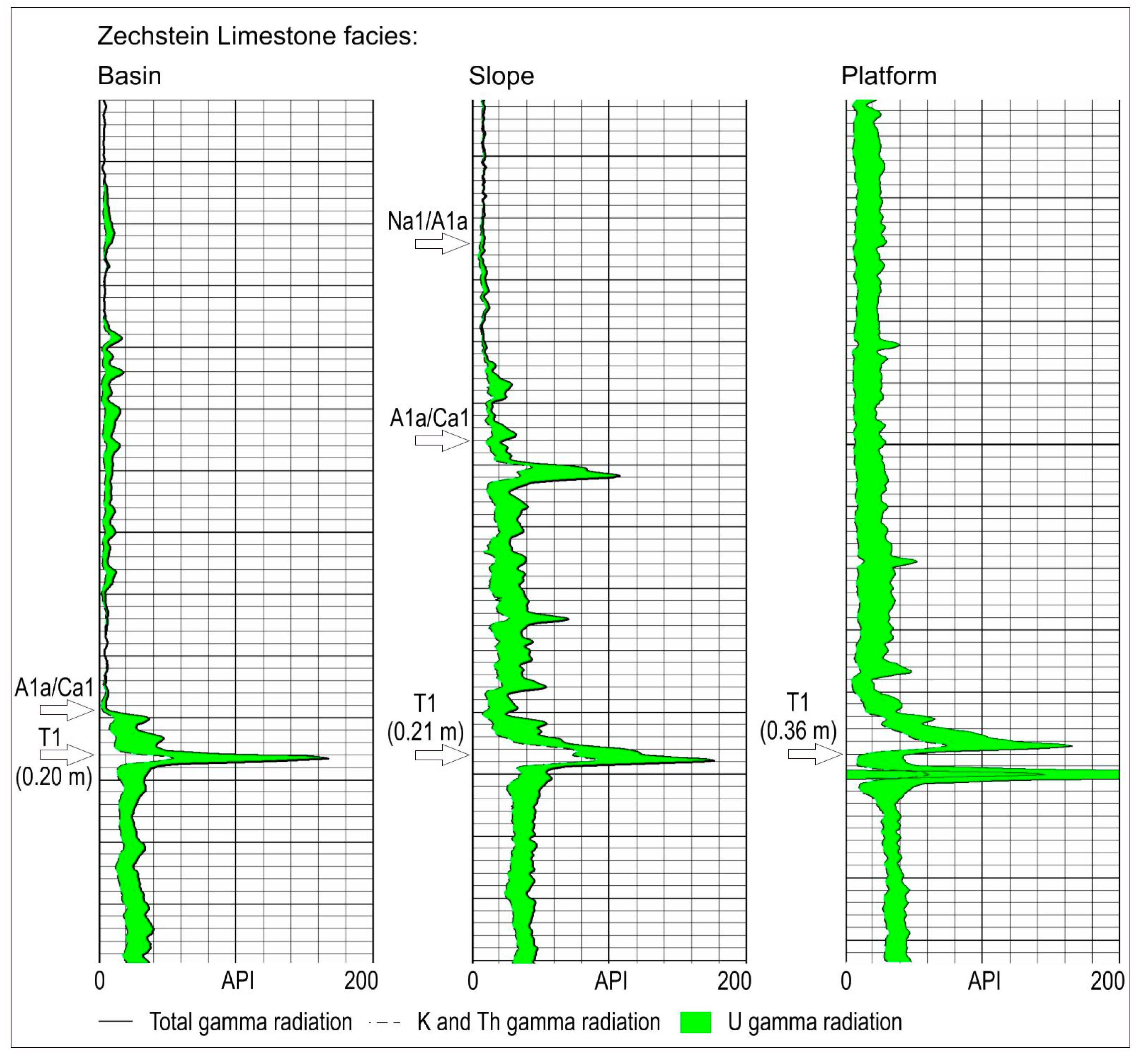Characteristics of Natural Background Radiation in the Lubin Mine, Poland
Abstract
1. Introduction
1.1. Description of Deposit
1.2. Site Geology
2. Materials and Methods
2.1. In Situ Gamma Spectrometry
2.2. In Situ Radon Measurement in Air
2.3. α and 𝛾 Laboratory Spectrometry Techniques
2.4. Neutron Flux Measurements
3. Results and Discussion
3.1. Analysis of the Gamma-Ray Spectrum
3.2. The Ratio of K-40/Bi-214
3.3. Radon Concentration in Air
3.4. Radioactivity Content in Water and Rocks Samples
3.5. Qualitative Neutron Activation Analysis
3.6. Neutron Flux Results
3.7. Radiological Risk Assessment
3.8. Relation between Local Geology and Radiation Level
4. Conclusions
Author Contributions
Funding
Data Availability Statement
Acknowledgments
Conflicts of Interest
References
- SKB. 2022. Available online: https://www.skb.com/research-and-technology/laboratories/the-aspo-hard-rock-laboratory/ (accessed on 7 September 2022).
- Zalewska, A.; Pytel, W.; Chorowski, M.; Cygan, S.; Hanzel, S.; Januszewska, K.; Jaroń, L.; Kisiel, J.; Lankof, L.; Markiewicz, A.; et al. Laguna in Polkowice–Sieroszowice Mine in Poland. Acta. Phys. Pol. B 2010, 41, 1803–1820. [Google Scholar]
- Kisiel, J.; Budzanowski, M.; Chorowski, M.; Cygan, S.; Dorda, J.; Hanzel, S.; Harańczyk, M.; Horoszczak, L.; Januszewska, K.; Jaroń, L.; et al. SUNLAB—The Project of a Polish Underground Laboratory. AIP Conf. Proc. 2010, 1304, 326–330. [Google Scholar]
- Autiero, D.; Aysto, J.; Badertscher, A.; Bezrukov, L.; Bouchez, J.; Bueno, A.; Busto, J.; Campagne, J.-E.; Cavata, C.; Chaussard, L.; et al. Large underground, liquid based detectors for astro-particle physics in Europe: Scientific case and prospects. J. Cosm. Astropart. Phys. 2007, 2007, 011. [Google Scholar] [CrossRef]
- Hrynkiewicz, A.; Broda, R.J. Man and Ionizing Radiation; Wydaw Naukowe PWN: Warsaw, Poland, 2001; ISBN 9788301134952. (In Polish) [Google Scholar]
- Karnkowski, P.H. Origin and evolution of the Polish Rotliegend Basin. In Polish Geological Institute Special Papers 3; Polish Geological Institute: Warsaw, Poland, 1999. [Google Scholar]
- Błaszczyk, J.K. Palaeomorphology of Weissliegendes top as the control on facies variability in ore-bearing series of Lubin copperfield, southwestern Poland. Geol. Sudet. 1981, 16, 195–217, (In Polish, with English summary). [Google Scholar]
- Jerzykiewicz, T.; Kijewski, P.; Mroczkowski, J.; Teisseyre, A.K. Origin of the Weissliegendes deposits of the Fore-Sudetic Monocline. Geol. Sudet. 1976, 11, 57–97. (In Polish) [Google Scholar]
- Nemec, W.; Porębski, S.J. Weissliegendes sandstones: A transition from fluvial-aeolian to shallow-marine sedimentation (Lower Permian of the Fore-Sudetic Monocline). 1. Sedimentary structures and textural differentiation. Ann. Soc. Geol. Pol. 1977, 47, 387–418. [Google Scholar]
- Kaczmarek, W.; Wasilewska-Błaszczyk, M.; Dudek, M. The Impact of Lithological Variability of Reservoir Rocks on the Quality Parameters of the Cu-Ag Deposit, Lubin–Głogów Copper District (LGCD). Biul. Państw. Inst. Geol. 2018, 472, 105–120. [Google Scholar] [CrossRef]
- Peryt, T.M.; Jasionowski, M.; Raczyński, P.; Chłódek, K. Demise of the Jabłonna Reef (Zechstein Limestone) and the Onset of Gypsum Deposition (Wuchiapingian, West Poland): Carbonate-to-Evaporite Transition in a Saline Giant. J. Palaeogeogr. 2020, 9, 18. [Google Scholar] [CrossRef]
- Smith, D.B. Rapid Marine Transgressions and Regressions of the Upper Permian Zechstein Sea. JGS 1979, 136, 155–156. [Google Scholar] [CrossRef]
- Glennie, K.W.; Buller, A.T. The Permian Weissliegend of NW Europe: The Partial Deformation of Aeolian Dune Sands Caused by the Zechstein Transgression. Sediment. Geol. 1983, 35, 43–81. [Google Scholar] [CrossRef]
- Kucha, H. Geochemistry of the Kupferschiefer, Poland. Geol. Rundsch. 1990, 79, 387–399. [Google Scholar] [CrossRef]
- Oszczepalski, S.; Rydzewski, A. Palaeogeography and Sedimentary Model of the Kupferschiefer in Poland. In The Zechstein Facies in Europe; Peryt, T.M., Ed.; Springer: Berlin/Heidelberg, Germany, 1987; Volume 10, pp. 189–205. ISBN 9783540177104. [Google Scholar]
- Piestrzyński, A. Uranium and Thorium in the Kupferschiefer Formation, Lower Zechstein, Poland. Mineral. Depos. 1990, 25, 146–151. [Google Scholar] [CrossRef]
- Kucha, H.; Przylowicz, W. Noble Metals in Organic Matter and Clay-Organic Matrices, Kupferschiefer, Poland. Econ. Geol. 1999, 94, 1137–1162. [Google Scholar] [CrossRef]
- Wagner, R. Sediment stratigraphy and development of the Zechstein Basin in the Polish Lowlands. Państw. Inst. Geol. 1994, 146, 1–71. [Google Scholar]
- Salski, W. Rozwój tektoniczny obszaru miedzionośnego monokliny przedsudeckiej. Tectonic development of the copper-bearing area of the Fore-Sudetic Monocline. Ann. Soc. Geol. Pol. 1977, 47, 27–48. (In Polish) [Google Scholar]
- Dumicz, M.; Don, J. Analiza strukturalna monokliny przedsudeckiej w rejonie Polkowic [Structural analysis of the Fore-Sudetic Homocline in vicinities of Polkowice]. Acta Univ. Wratislav. 1977, 378, 279–297. (In Polish). Prace Geologiczno-Mineralogiczne [Google Scholar]
- Szkliniarz, K.; Walencik-Łata, A.; Kisiel, J.; Polaczek-Grelik, K.; Jędrzejczak, K.; Kasztelan, M.; Szabelski, J.; Orzechowski, J.; Tokarski, P.; Marszał, W.; et al. Characteristics of Natural Background Radiation in the Polkowice-Sieroszowice Mine, Poland. Energies 2021, 14, 4261. [Google Scholar] [CrossRef]
- Walencik-Łata, A.; Szkliniarz, K.; Kisiel, J.; Polaczek-Grelik, K.; Jędrzejczak, K.; Kasztelan, M.; Szabelski, J.; Orzechowski, J.; Tokarski, P.; Marszał, W.; et al. Characteristics of Natural Background Radiation in the GIG Experimental Mine ‘Barbara’, Poland. Energies 2022, 15, 685. [Google Scholar] [CrossRef]
- Petoussi-Henss, N.; Bolch, W.E.; Eckerman, K.F.; Endo, A.; Hertel, H.; Hunt, J.; Pelliccioni, M.; Schlattl, H.; Zankl, M. Conversion Coefficients for Radiological Protection Quantities for External Radiation Exposures; Publication 116; Ann. ICRP 40(2–5); ICRP: Stockholm, Sweden, 2010. [Google Scholar]
- Suomela, J. Method for Determination of U-Isotopes in Water; Swedish Radiation Institute Document 0282-4434, No. 93-14; Swedish Radiation Institute: Stockholm, Sweden, 1993. [Google Scholar]
- Sill, C.W. Precipitation of Actinides as Fluorides or Hydroxides for High-Resolution Alpha Spectrometry. Nucl. Chem. Waste Manag. 1987, 7, 201–215. [Google Scholar] [CrossRef]
- Walencik-Łata, A.; Smołka-Danielowska, D. 234U, 238U, 226Ra, 228Ra and 40K Concentrations in Feed Coal and Its Combustion Products during Technological Processes in the Upper Silesian Industrial Region, Poland. Environ. Pollut. 2020, 267, 115462. [Google Scholar] [CrossRef]
- Walencik-Łata, A.; Kozłowska, B.; Przylibski, T.A. Hydrochemical Behaviour of Dissolved Uranium in Selected Groundwaters of the Kłodzko Valley (SW Poland) and Its Application Possibilities as an Environmental Tracer. Chemosphere 2021, 267, 128911. [Google Scholar] [CrossRef] [PubMed]
- Agostinelli, S.; Allison, J.; Amako, K.; Apostolakis, J.; Araujo, H.; Arce, P.; Asai, M.; Axen, D.; Banerjee, S.; Barrand, G.; et al. Geant4—A Simulation Toolkit. Nuclear Instruments and Methods in Physics Research Section A: Accelerators, Spectrometers, Detectors and Associated Equipment 2003, 506, 250–303. [Google Scholar] [CrossRef]
- Malczewski, D.; Kisiel, J.; Dorda, J. Gamma Background Measurements in the Laboratoire Souterrain de Modane. J. Radioanal. Nucl. Chem. 2012, 292, 751–756. [Google Scholar] [CrossRef]
- Malczewski, D.; Kisiel, J.; Dorda, J. Gamma Background Measurements in the Boulby Underground Laboratory. J. Radioanal. Nucl. Chem. 2013, 298, 1483–1489. [Google Scholar] [CrossRef] [PubMed]
- Malczewski, D.; Kisiel, J.; Dorda, J. Gamma Background Measurements in the Gran Sasso National Laboratory. J. Radioanal. Nucl. Chem. 2013, 295, 749–754. [Google Scholar] [CrossRef] [PubMed]
- Polaczek-Grelik, K.; Kisiel, J.; Walencik-Łata, A.; Mietelski, J.W.; Janowski, P.; Harańczyk, M.; Jurkowski, J.; Zalewska, A.; Kobziński, J.; Markowski, P.; et al. Lead shielding efficiency from the gamma background measurements in the salt cavern of the Polkowice–Sieroszowice copper mine. J. Radioanal. Nucl. Chem. 2015, 308, 773–780. [Google Scholar] [CrossRef] [PubMed][Green Version]
- Kisiel, J.; Budzanowski, M.; Dorda, J.; Kozak, K.; Mazur, J.; Mietelski, J.W.; Puchalska, M.; Tomankiewicz, E.; Zalewska, A. Measurements of natural radioactivity in the salt cavern of the Polkowice-Sieroszowice copper mine. Acta Phys. Pol. B 2010, 41, 1813–1819. [Google Scholar]
- Coccia, E. Underground laboratories: Cosmic silence, loud science. J. Phys. Conf. Ser. 2010, 203, 012023. [Google Scholar] [CrossRef]
- Polaczek-Grelik, K.; Walencik-Lata, A.; Szkliniarz, K.; Kisiel, J.; Jedrzejczak, K.; Szabelski, J.; Mueller, T.; Schreiter, F.; Djakonow, A.; Lewandowski, R.; et al. Characterization of the Radiation Environment at TU Bergakademie in Freiberg, Saxony, Germany. Nucl. Instrum. Methods Phys. Res. Sect. A Accel. Spectrometers Detect. Assoc. Equip. 2019, 946, 162652. [Google Scholar] [CrossRef]
- Polaczek-Grelik, K.; Walencik-Łata, A.; Szkliniarz, K.; Kisiel, J.; Jȩdrzejczak, K.; Szabelski, J.; Kasztelan, M.; Orzechowski, J.; Tokarski, P.; Marszał, W.; et al. Natural Background Radiation at Lab 2 of Callio Lab, Pyhäsalmi Mine in Finland. Nucl. Instrum. Methods Phys. Res. Sect. A Accel. Spectrometers Detect. Assoc. Equip. 2020, 969, 164015. [Google Scholar] [CrossRef]
- Council Directive 2013/59/Euratom of 5 December 2013 Laying down Basic Safety Standards for Protection against the Dangers Arising from Exposure to Ionising Radiation, and Repealing Directives 89/618/Euratom, 90/641/Euratom, 96/29/Euratom, 97/43/Euratom and 2003/122/Euratom. Available online: https://eur-lex.europa.eu/LexUriServ/LexUriServ.do?uri=OJ:L:2014:013:0001:0073:EN:PDF (accessed on 8 November 2022).
- Decree of the Polish Council of Ministers. Dz.U. 2001, No. 3, Poz. 18. 2001; (In Polish). Available online: https://isap.sejm.gov.pl/isap.nsf/download.xsp/WDU20010030018/U/D20010018Lj.pdf (accessed on 8 November 2022).
- Decree of the Polish Ministry of Health. M.P. 2021 poz. 169. 22 January 2021; (In Polish). Available online: https://isap.sejm.gov.pl/isap.nsf/download.xsp/WMP20210000169/O/M20210169.pdf (accessed on 8 November 2022).
- Liu, C.; Ma, H.; Zeng, Z.; Cheng, J.; Li, J.; Zhang, H. Measurements of Radon Concentrations Using CR-39 Detectors in China JinPing Underground Laboratory (2015–2016). arXiv 2018, arXiv:1806.06567. [Google Scholar]
- Zuzel, G. Experience of gas purification and radon control in BOREXINO. AIP Conf. Proc. 2018, 1921, 050001. [Google Scholar] [CrossRef]
- Benato, G.; Biare, D.; Bucci, C.; Paolo, L.D.; Drobizhev, A.; Kadel, R.W.; Kolomensky, Y.G.; Schreiner, J.; Singh, V.; Sipla, T.; et al. Radon Mitigation during the Installation of the CUORE 0νββ Decay Detector. J. Inst. 2018, 13, P01010. [Google Scholar] [CrossRef]
- Štekl, I.; Hůlka, J.; Mamedov, F.; Fojtík, P.; Čermáková, E.; Jílek, K.; Havelka, M.; Hodák, R.; Hýža, M. Low Radon Cleanroom for Underground Laboratories. Front. Public Health 2021, 8, 589891. [Google Scholar] [CrossRef] [PubMed]
- Udovičić, V.; Grabež, B.; Dragić, A.; Banjanac, R.; Joković, D.; Panić, B.; Joksimović, D.; Puzović, J.; Aničin, I. Radon Problem in an Underground Low-Level Laboratory. Radiat. Meas. 2009, 44, 1009–1012. [Google Scholar] [CrossRef]
- European Commission, Directorate-General for Environment, Radiological Protection Principles Concerning the Natural Radioactivity of Building Materials, Publications Office. 2000. Available online: https://op.europa.eu/en/publication-detail/-/publication/988f3243-5259-43a5-b621-fbff662deeb0/language-en (accessed on 8 November 2022).
- Piestrzyński, A. Uranium and thorium in copper ore deposits on the Fore-Sudetic Monocline (SW Poland). Mineral. Pol. 1989, 20, 41–56. [Google Scholar]
- Sun, Y.-Z.; Jinxi, W.; Shifeng, L.; Kankun, J.; Mingyue, L. Mechanism of Uranium Accumulation in the Kupferschiefer from Poland and Germany. Energy Explor. Exploit. 2005, 23, 463–473. [Google Scholar] [CrossRef]
- Paces, J.B.; Ludwig, K.R.; Peterman, Z.E.; Neymark, L.A. 234U/238U Evidence for Local Recharge and Patterns of Ground-Water Flow in the Vicinity of Yucca Mountain, Nevada, USA. Appl. Geochem. 2002, 17, 751–779. [Google Scholar] [CrossRef]
- Osmond, J.K.; Cowart, J.B. U-series nuclides as tracers in groundwater hydrology. In Environmental Tracers in Subsurface Hydrogeology; Cook, P.G., Herczeg, A.L., Eds.; Kluwer Academic Publishers: New York, NY, USA, 2000. [Google Scholar]
- Suksi, J. Natural Uranium as a Tracer in Radionuclide Geosphere Transport Studies. Ph.D. Thesis, University of Helsinki, Helsinki, Finland, 2001. Available online: https://urn.fi/URN:ISBN:952-10-0222-0 (accessed on 8 November 2022).
- Jasaitis, D.; Pečiulienė, M. Natural Radioactivity and Radon Exhalation from Building Materials in Underground Parking Lots. Appl. Sci. 2021, 11, 7475. [Google Scholar] [CrossRef]
- Medhat, M.E. Assessment of Radiation Hazards Due to Natural Radioactivity in Some Building Materials Used in Egyptian Dwellings. Radiat. Prot. Dosim. 2009, 133, 177–185. [Google Scholar] [CrossRef]
- Lu, X.; Li, L.Y.; Wang, F.; Wang, L.; Zhang, X. Radiological Hazards of Coal and Ash Samples Collected from Xi’an Coal-Fired Power Plants of China. Environ. Earth Sci. 2012, 66, 1925–1932. [Google Scholar] [CrossRef]
- Nwankwo, C.U.; Ogundare, F.O.; Folley, D.E. Radioactivity Concentration Variation with Depth and Assessment of Workers’ Doses in Selected Mining Sites. J. Radiat. Res. Appl. Sci. 2015, 8, 216–220. [Google Scholar] [CrossRef]
- United Nations Scientific Committee on the Effects of Atomic Radiation (UNSCEAR). Sources and Effects of Ionizing Radiation: Sources; United Nations Publications: New York, NY, USA, 2000. [Google Scholar]
- Inoue, K.; Fukushi, M.; Van Le, T.; Tsuruoka, H.; Kasahara, S.; Nimelan, V. Distribution of Gamma Radiation Dose Rate Related with Natural Radionuclides in All of Vietnam and Radiological Risk Assessment of the Built-up Environment. Sci. Rep. 2020, 10, 12428. [Google Scholar] [CrossRef]
- Tzortzis, M.; Tsertos, H.; Christofides, S.; Christodoulides, G. Gamma Radiation Measurements and Dose Rates in Commercially-Used Natural Tiling Rocks (Granites). J. Environ. Radioact. 2003, 70, 223–235. [Google Scholar] [CrossRef]
- The 2007 Recommendations of the International Commission on Radiological Protection. ICRP Publication 103. Ann. ICRP 2007, 37, 1–332. [Google Scholar] [CrossRef]
- Gluyas, J.; Swarbrick, R. Petroleum Geoscience; Blackwell Publishing: Hoboken, NJ, USA, 2004; ISBN 0632037679. [Google Scholar]
- Zielinski, R.A.; Bloch, S.; Walker, T.R. The Mobility and Distribution of Heavy Metals during the Formation of First Cycle Red Beds. Econ. Geol. 1983, 78, 1574–1589. [Google Scholar] [CrossRef]
- Kucha, H. Platinum-Group Metals in the Zechstein Copper Deposits, Poland. Econ. Geol. 1982, 77, 1578–1591. [Google Scholar] [CrossRef]
- Baudzis, A.; Marzec, D. Report on lithological wire logs data. Geofizyka Toruń: Toruń, Poland, 2019; (unpublished work). [Google Scholar]
- Baudzis, A.; Marzec, D. Report A on lithological wire logs data. Geofizyka Toruń: Toruń, Poland, 2020; (unpublished work). [Google Scholar]
- Baudzis, A.; Marzec, D. Report B on lithological wire logs data. Geofizyka Toruń: Toruń, Poland, 2020; (unpublished work). [Google Scholar]
- Enqvist, T.; Mattila, A.; Föhr, V.; Jämsén, T.; Lehtola, M.; Narkilahti, J.; Joutsenvaara, J.; Nurmenniemi, S.; Peltoniemi, J.; Remes, H.; et al. Measurements of Muon Flux in the Pyhäsalmi Underground Laboratory. Nucl. Instrum. Methods Phys. Res. Sect. A Accel. Spectrometers Detect. Assoc. Equip. 2005, 554, 286–290. [Google Scholar] [CrossRef]






| Decay Chain | Nuclide | Apparent [Bq/cm2] | Δ [Bq/cm2] | EDR [pSv/s] | Δ [pSv/s] | % to EDR |
|---|---|---|---|---|---|---|
| Uranium | 234Th | 0.24 | 0.05 | 0.004 | 0.001 | 0.02 |
| 234mPa | 1.62 | 0.36 | 0.042 | 0.007 | 0.22 | |
| 226Ra | 1.04 | 0.28 | 0.020 | 0.003 | 0.10 | |
| 214Bi | 1.60 | 0.29 | 6.678 | 0.978 | 34.23 | |
| 214Pb | 0.75 | 0.08 | 0.494 | 0.072 | 2.53 | |
| Thorium | 228Ac | 0.49 | 0.18 | 1.134 | 0.166 | 5.81 |
| 208Tl | 0.23 | 0.07 | 2.847 | 0.404 | 14.59 | |
| 212Pb | 0.30 | 0.04 | 0.094 | 0.013 | 0.48 | |
| 212Bi | 0.66 | 0.19 | 0.184 | 0.032 | 0.94 | |
| None | 40K | 15.36 | 1.68 | 7.733 | 1.095 | 39.64 |
| 231Th | 0.51 | 0.07 | 0.008 | 0.001 | 0.04 | |
| X-rays | 0.188 | 0.027 | 0.96 | |||
| Annihilation | 0.083 | 0.012 | 0.42 |
| Sample | 226Ra [Bq/kg] | 228Ra(228Ac) [Bq/kg] | 40K [Bq/kg] | 238U [Bq/kg] | 234U [Bq/kg] | U [mg/kg] | 234U/238U | 226Ra/238U |
|---|---|---|---|---|---|---|---|---|
| sandstone | 40.1 ± 1.5 | 16.5 ± 0.5 | 586 ± 10 | 58.1 ± 3.2 | 58.2 ± 3.2 | 4.7 ± 0.3 | 1.0 ± 0.1 | 0.7 ± 0.1 |
| sandstone | 37.3 ± 1.4 | 16.1 ± 0.4 | 531 ± 9 | 45.5 ± 4.7 | 43.4 ± 4.6 | 3.7 ± 0.4 | 1.0 ± 0.1 | 0.8 ± 0.1 |
| dolomite | 65.9 ± 2.4 | 17.2 ± 0.4 | 641 ± 10 | 61.6 ± 4.5 | 55.5 ± 4.1 | 5.0 ± 0.4 | 0.9 ± 0.1 | 1.1 ± 0.1 |
| dolomite | 79.0 ± 2.9 | 16.1 ± 0.4 | 580 ± 10 | 87.3 ± 5.7 | 86.1 ± 5.6 | 7.1 ± 0.5 | 1.0 ± 0.1 | 0.9 ± 0.1 |
| shale | 186 ± 7 | 21.5 ± 0.5 | 747 ± 12 | 129 ± 8 | 124 ± 7 | 10.5 ± 0.6 | 1.0 ± 0.1 | 1.4 ± 0.1 |
| shale | 247 ± 9 | 30.0 ± 0.8 | 927 ± 15 | 249 ± 19 | 247 ± 18 | 20.2 ± 1.5 | 1.0 ± 0.1 | 1.0 ± 0.1 |
| Centronic | ZDAJ |
|---|---|
| 8.1 ± 1.8 | 3.9 ± 1.1 |
| 7.6 ± 2.1 | 3.5 ± 1.1 |
| 7.3 ± 2.7 | 3.3 ± 1.0 |
| 7.8 ± 2.3 | 3.5 ± 1.7 |
| Location | Flux of Thermal Neutrons (×10−6 cm −2 s −1) |
|---|---|
| Lubin (Poland) (this work) | 4.2 ± 0.9 |
| Polkowice-Sieroszowice (Poland) | 2.0 ± 0.2 |
| Barbara (Poland) | 8.6 ± 1.1 |
| Gran Sasso, (Italy) | 0.56 ± 0.22 |
| Slanic Prahova, (Romania) | 0.12 ± 0.05 |
| Freiberg, (Germany) | 3.12 ± 0.10 |
| Pyhäsalmi; Lab2 (Finland) | 17.30 ± 0.10 |
| Sample | Raeq [Bq/kg] | Hex | D [nGy/h] | ED [mSv/y] |
|---|---|---|---|---|
| sandstone | 109 | 0.29 | 373 | 0.43 |
| sandstone | 101 | 0.27 | 339 | 0.39 |
| dolomite | 140 | 0.38 | 418 | 0.48 |
| dolomite | 147 | 0.40 | 387 | 0.45 |
| shale | 274 | 0.74 | 538 | 0.62 |
| shale | 362 | 0.98 | 675 | 0.78 |
Publisher’s Note: MDPI stays neutral with regard to jurisdictional claims in published maps and institutional affiliations. |
© 2022 by the authors. Licensee MDPI, Basel, Switzerland. This article is an open access article distributed under the terms and conditions of the Creative Commons Attribution (CC BY) license (https://creativecommons.org/licenses/by/4.0/).
Share and Cite
Walencik-Łata, A.; Szkliniarz, K.; Kisiel, J.; Polaczek-Grelik, K.; Jędrzejczak, K.; Kasztelan, M.; Szabelski, J.; Orzechowski, J.; Tokarski, P.; Marszał, W.; et al. Characteristics of Natural Background Radiation in the Lubin Mine, Poland. Energies 2022, 15, 8478. https://doi.org/10.3390/en15228478
Walencik-Łata A, Szkliniarz K, Kisiel J, Polaczek-Grelik K, Jędrzejczak K, Kasztelan M, Szabelski J, Orzechowski J, Tokarski P, Marszał W, et al. Characteristics of Natural Background Radiation in the Lubin Mine, Poland. Energies. 2022; 15(22):8478. https://doi.org/10.3390/en15228478
Chicago/Turabian StyleWalencik-Łata, Agata, Katarzyna Szkliniarz, Jan Kisiel, Kinga Polaczek-Grelik, Karol Jędrzejczak, Marcin Kasztelan, Jacek Szabelski, Jerzy Orzechowski, Przemysław Tokarski, Włodzimierz Marszał, and et al. 2022. "Characteristics of Natural Background Radiation in the Lubin Mine, Poland" Energies 15, no. 22: 8478. https://doi.org/10.3390/en15228478
APA StyleWalencik-Łata, A., Szkliniarz, K., Kisiel, J., Polaczek-Grelik, K., Jędrzejczak, K., Kasztelan, M., Szabelski, J., Orzechowski, J., Tokarski, P., Marszał, W., Przybylak, M., Stolecki, L., Selerowicz, T., & Fuławka, K. (2022). Characteristics of Natural Background Radiation in the Lubin Mine, Poland. Energies, 15(22), 8478. https://doi.org/10.3390/en15228478







